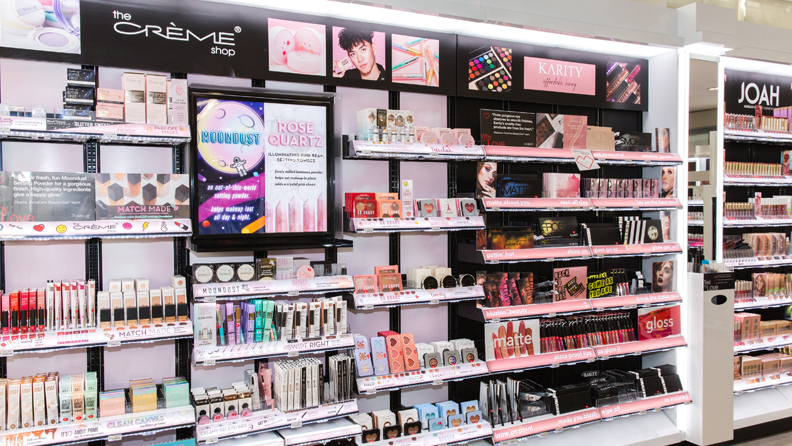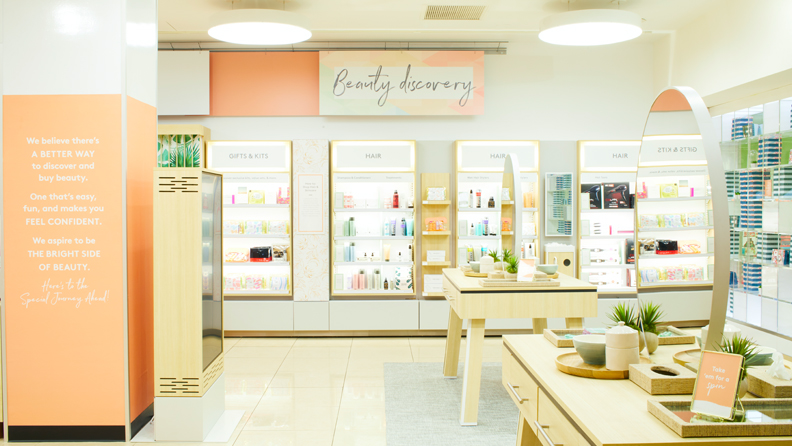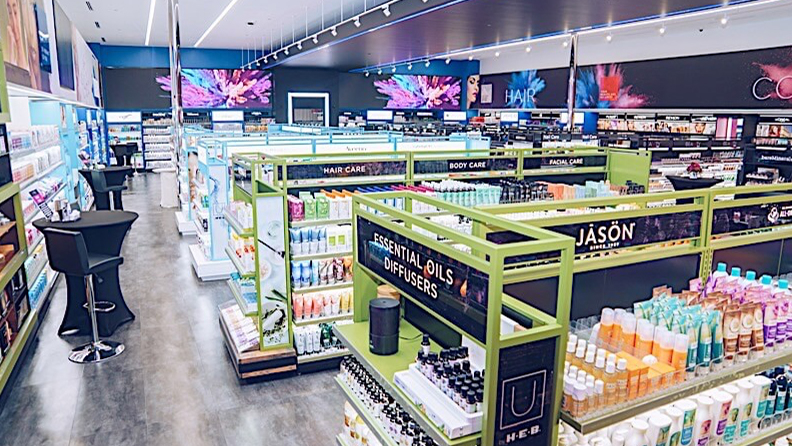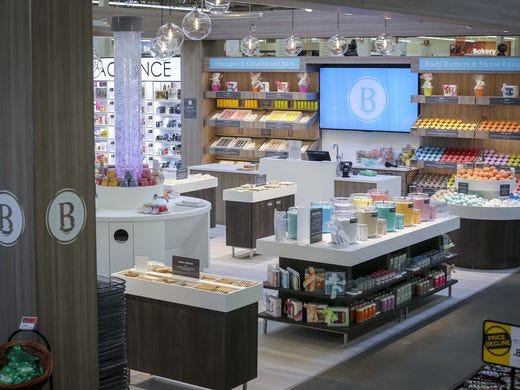Efforts mass marketers are making to elevate the shopping experience and product assortment could be paying off. After two years of flat growth, Nielsen numbers for the 52-week period ended December 29, 2019, show overall health and beauty care sales in mass doors advancing 1.7%—a small but notable increase.
Mass marketers still have a lot of ground to regain, having lost their once-dominant share of beauty sales to online, department, and specialty stores. They are digging into their toolbox.
Specifically, the physical appearance and in-store experience are being overhauled from rows and rows of sameness to “Sephora-inspired” fixtures. Beyond the ambiance, big-box chains are working with private-label companies to offer exclusives—often co-created with a celebrity or social star. The evolution isn’t only in drug and discount stores, but even food and dollar chains as well.
“These enhanced departments can bring people back [into mass] because people want to buy under one roof,” says Wendy Liebmann, founder and Chief Executive Officer of WSL Strategic Retail, adding if the store looks better with elevated merchandise people could buy more. “It has to feel like a beauty department that isn’t just rote.”

Two of the frontrunners in burnishing their image are CVS and Target. Buoyed by success in four pilot stores, CVS is doubling down on its new BeautyIRL format. The nation’s largest drugstore chain in store count ended the year with 48 of the sparkling formats that give legacy brands special boutique gondolas, while punctuating indie and exclusive brands in dedicated areas. Borrowing a page from prestige, there is a Glamsquad-staffed makeup table where experts perform services such as blowouts, dry styling, accent braids, makeup with add-ons like false lashes, tutorials, and ear piercing in a partnership with Studex. CVS also has a new format called HUBS with an overall wellness positioning.
Other physical wrinkles include special hot spots for new products, a “social wall” for brands once only found online, a massive travel/trial size department, illuminated fixtures, and more than 1,000 testers with hygiene amenities—a feature virtually unheard of in the mass market. Collateral materials in CVS bear a mark that lets consumers know photos haven’t been photoshopped as well as a note if they have been altered as part of its Beauty Mark campaign. Footage in BeautyIRL is one-and-a-half times larger than traditional CVS beauty floors, which average around 1,100-square feet.
“We recognized an opportunity to deliver a more inspiring, interactive in-store experience,” says Maly Bernstein, Vice President of Beauty and Personal Care for CVS Health.
Target is also putting bucks into beauty. Target 2.0 stores have elegant lighting separating the beauty department, concierge stations for sampling or assistance, and a men’s department that has many shoppers doing a double-take to make sure they are in a discount store. Boring end-of-aisle displays have been replaced by cool fixtures housing current trends like natural products or haircare for textured tresses. “The departments are airy with big bold signs,” says Liebmann.

Walgreens inked a deal with Birchbox that not only netted the chain brands it could never secure on its own, but also a department that resembles an elegant boudoir rather than a drugstore. The footprint is undergoing refinement, settling in on what Katia Beauchamp, Birchbox cofounder and Chief Executive Officer, calls a “small-expression” department. Last November she announced the release of 500 of these shops-in-shops within Walgreens doors. Birchbox presents a curated assortment of its brands in the Walgreens doors as a way to reach consumers who may not have been exposed to the subscription service.
Walgreens’ upgrade goes beyond Birchbox. The chain has been adding lighting and enhanced fixtures over the past few years. But in an apparent change of course, the chain is starting to emphasize its mass-market core brands versus the Boots lines like No7 it has been moving to the front of the department. In a store near its headquarters in Deerfield, Ill., Walgreens swapped out the footage for No7 for L’Oréal. The message: the dream of mimicking the success of Boots brands in the UK might not be obtainable in the US. Front-end sales haven’t been perking as Walgreens had hoped. Fiscal first-quarter sales declined 2.2% versus the same period last year.
While Walgreens doubles down on value, Walmart is teaming up affordability with more on-trend product assortments.
Ambience might not be a word typically associated with Walmart, but the chain is also trying to inject glamour into its stores. That’s hard to scale across almost 5,000 doors, admits Jody Pinson, Vice President of Merchandising Beauty at Walmart, but more stores are getting a white-glove treatment of lighted fixtures and “discovery zones” for trendy new products. Walmart is also toying with more technology such as iPads with product information on shelves.
Many of the upgrades in the US owe their inspiration to Shoppers Drug Mart in Canada, which has always set the pace with elegant store designs and premium brands like Clarins, Dior, and Nars.

One of the most upscale presentations in the mass landscape is in an unlikely candidate—a supermarket. H-E-B is not an ordinary food store, and its cosmetics department is one reason why. Recently the retailer spruced up its already-famous beauty department to a new level. Called Beauty by H-E-B, the new look has brands unheard of in the mass market along with service from beauty advisers who undergo 100 hours of training. The first signs of the fresh look were revealed late last year in a 4,000-square-foot boutique in a San Antonio store complete with a pink runway leading to the department.
The sleek fixturing is reminiscent of Sephora and the area is loaded with features such as mirrored testing stations, digital screens with information videos and access to share photos on social media and lines and brands not typically sold at mass—let alone a food chain. Those include Smashbox, Pixi, and K-beauty brand AHC. “Beauty by H-E-B provides that oasis within the store where the customer can pamper themselves,” Tracy Bliss, Director of Beauty at H-E-B, said in a statement. “We’ve created a destination within the store where a talented team of beauty advisers will help customers pick out the perfect items that lend themselves to the creation of new beauty rituals.” The souped-up department is in a testing period, the company says, before rolling out.

H-E-B isn’t the only retailer warming up to selling blush with broccoli. Hy-Vee is singled out in the industry for its efforts in bath and body with a partnership with a brand named Basin (also sold in the new CVS format). “I was in Hy-Vee recently and what started as a relationship with Basin has grown into an enhanced beauty department, especially in the stores where they sell other items like soft goods,” observers Liebmann. While Basin is the focal point, Hy-Vee has at times offered brand names such as Stila, Philosophy, and OPI in the beauty area. Select doors have trained beauty advisors, as well.
Most recently, Walgreens and Kroger expanded a partnership that started in 2018 where some of Kroger’s owned food brands were sold in select Walgreens stores. Now Kroger has a chance to offer some of Walgreens’ lineup, including No7 in a pilot program at 17 stores in Knoxville, Tenn. That raises some industry eyebrows at the thought of the revered logo presented in a totally self-serve environment. But Walgreens’ co-Chief Operating Officer Alex Gourlay called the partnership a “strong opportunity” to put the retailer’s health and beauty products in front of Kroger shoppers. He said No7 produced a midteen sales jump.
One former retailer suggests Walgreens is just trying to plump up sales for the brand. “The halo effect from Kroger won’t last,” he says.
In the meantime, Dollar Stores are giving beauty a makeover. Dollar General recently launched its own brand called Believe which is housed in a fixture that could hold its own in a Sephora, according to Scott Oshry, Chief Marketing Officer for Maesa, the company that created Believe.
Exclusive brands are part of the prescription for mass doors to build loyalty, gross margins (private label typically delivers higher profits), an elevated assortment, and competitive advantage.
According to the PLMA (Private Label Manufacturers Association), health and beauty store brands are worth about $16 billion representing an 18% share of sales.
Beyond Dollar General, CVS, Target, Walmart, Aldi, Ulta Beauty, Kroger, and even Amazon are among the mega-retailers putting a fresh spin on beauty exclusives. Many view exclusives as an avenue to build back sales rather than watching online and specialty stores siphon off shoppers.
These are not your mother’s private labels—which were merely dupes of national brands. The new era of proprietary labels are brands in their own right. Sometimes they fill a gap in the market if a chain can’t secure a category; other times they elevate the existing assortment. “In many cases, the consumer is unaware the retailer owns or is involved with the brand,” says Ben Bennett, formerly of HatchBeauty, who just launched his own new company to build out brands called The Center.
Among the latest exclusives are TPH by Taraji P. Henson, a haircare line exclusive at Target from Maesa, Hairitage, an influencer-collaboration (Mindy McKnight founder of YouTube channel. CuteGirlsHairstyles) sold only at Walmart, and Ulta Beauty’s Florence by Mills, a collection made with input from Millie Bobby Brown by Beach House. Last year, Dollar General’s Believe launched, along with Cleen Beauty and Earth to Skin at Walmart, and Amazon private label called Belei.
Target has always been at the head of the class in exclusives—its Kristin Ess has morphed into a $100 million franchise. Recently, Walmart has borrowed a page from the Target playbook and doubled down on its push into exclusive brands. Ulta Beauty, which has an extensive private-label collection, is looking for more influencer and celebrity deals such as the recently launched Pattern haircare from Tracee Ellis Ross and the previously mentioned Florence.
Just like indie brands, these exclusives muscle into the market with social media. Retailers didn’t use to have the bandwidth to compete with national brands; now with one post they get big exposure, explains Maesa’s Oshry.
With the shiny new stores and revved-up products, the biggest challenge will be convincing shoppers, especially Gen Z and millennials, that it is hip to shop the local Walmart or CVS. And, with these chains operating so many stores, the quest will be to duplicate the panache outside of the prototypes.